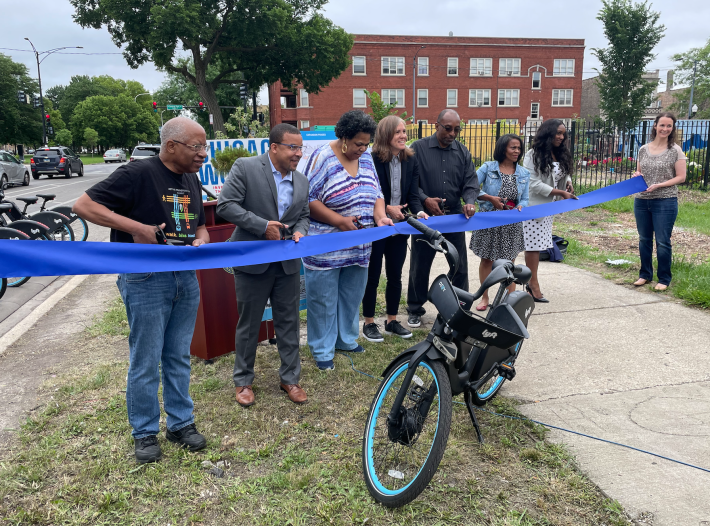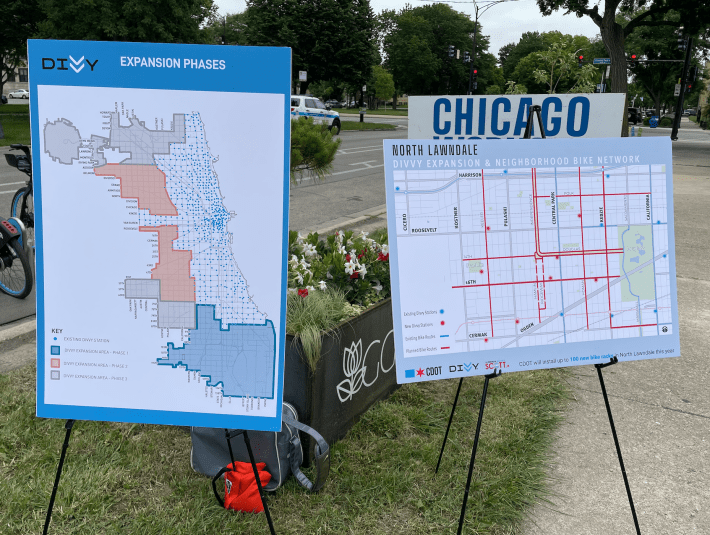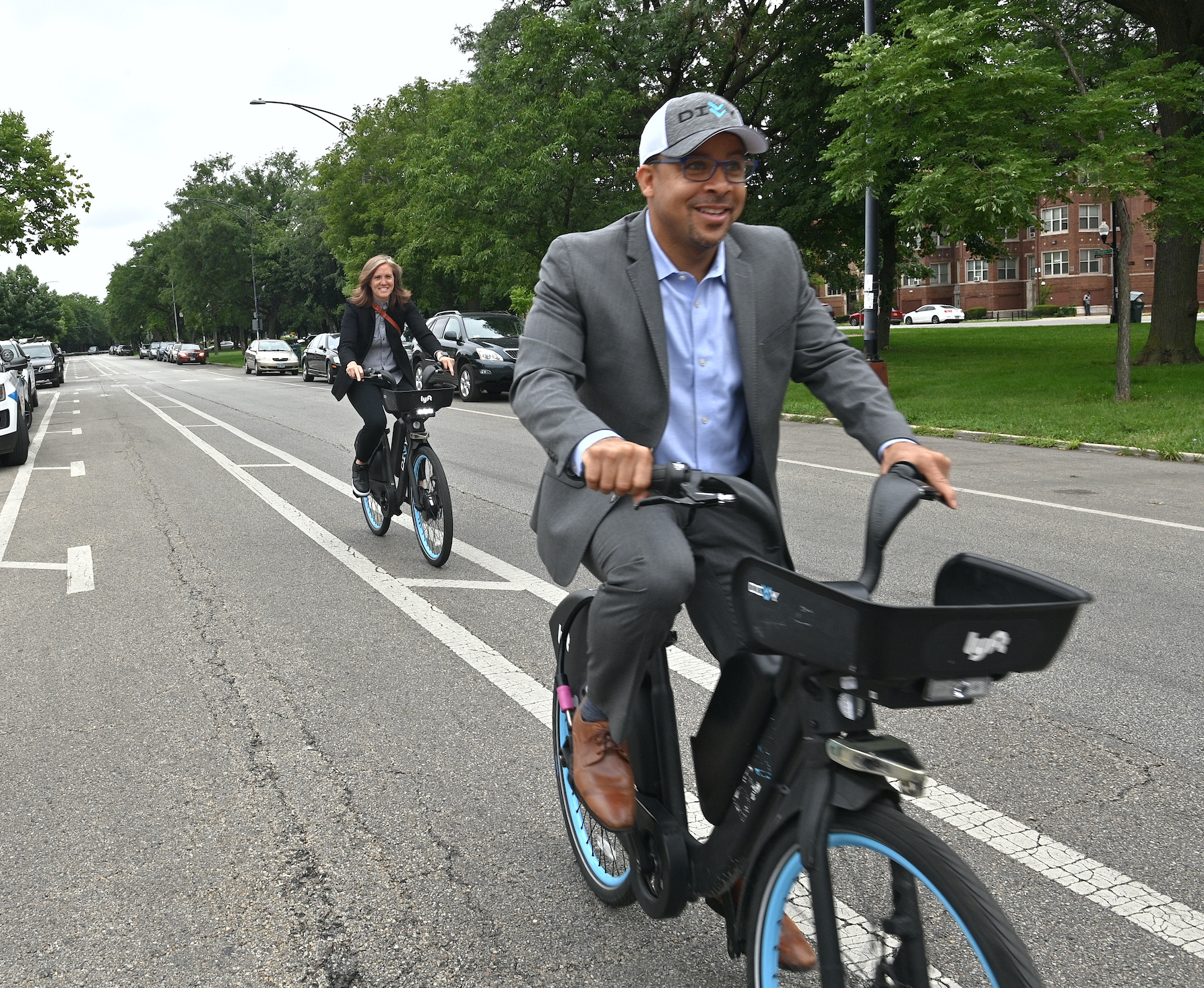Yesterday city officials held a ribbon-cutting ceremony at Douglas Boulevard and Central Park Avenue in North Lawndale to kick off the next phase of Divvy expansion into Chicago's West Side, adding 3,500 new electric bikes. The event also celebrated the installation of 107 new "e-stations," bike rack installations intended for parking electric Divvy bikes, within a 35-square mile area of the Southwest and Northwest Sides of the city.
Another 48 new e-stations will also be installed within the existing service area to improve station density in underserved areas. When the expansion is completed, the Divvy system will include 7,000 e-bikes, 16,500 total bikes and more than 800 stations, and the service area will cover 190 square miles. The city says the expansion is creating 200 new jobs.
In a change in strategy, the new West Side service areas will not be getting any of the traditional docking stations, which means that it will be impossible to park the older blue non-electric bikes in these zones. However, the black e-bikes have built-in cable locks, which allow them to be parked at the e-stations, standard bike racks, poles, or any other legal bike parking spot. The e-stations are portable and incorporate rubber mats made from recycled sneakers and tires. See a photo of a new e-station near the bottom of this post.
“We’re really focused on getting these next phases out," said Chicago Department of Transportation commissioner Gia Biagi. "We’re talking city limits here in terms of that expansion. That’s one, making sure [the system is] working great. We want to make sure it’s effective. It’s not as if we put a station down and say it has to stay there forever. We want to make sure we’re adjusting, modifying, and then that continuing the investment in the infrastructure. That is how we make this sustainable.”

The city has earmarked funds for new bikeways to serve the Divvy expansion area through the city's new Chicago Works infrastructure plan. The plan includes $17 million for new bikeways installed in 2021 and 2022. "It’s not just about providing the bikes, it’s also about providing [cycling] infrastructure,” said Biagi. 45 miles of new bikeways are slated for installation over the next two years in the Belmont Cragin, Austin, and North Lawndale neighborhoods. Up to 100 standard bike racks will also be installed in each of the three communities.
Biagi thanked 24th Ward alderman Michael Scott Jr., the North Lawndale Community Coordinating Council, and local residents for their help planning the Divvy network in North Lawndale. NLCCC chair Rochelle Jackson has established 30 locally-oriented Facebook pages, and community members were invited to provide input on the Divvy plan via these pages.
"This is an important partnership between community and CDOT and my office, said Alderman Scott, who added that he rides bikes himself. "I can’t explain enough how important community input has been in... where we’re putting our Divvy stations. And I would just hope that other communities emulate what we’ve done. We did a lot of listening, CDOT did a lot of listening, the community had the vast majority of input.” Scott credited Jackson with helping to maximize community input for station placement, to help ensure the bikes are in suitable locations that can be accessed via safe cycling routes.

Jackson said that when officials first held a Zoom presentation with all the planned station sites on a map, she spotted several locations that she felt would have been less than ideal. “I said, so why not just do boots on the ground. I’ll take a day off of work and work with you and take you through North Lawndale to show you the difference between where you have it on the map and where it possible can be."
CDOT and Lyft also solicited station location input via community planning rides, online forums and surveys, youth-led feedback sessions, yard signs, and old-fashioned door-knocking. Although the process is still ongoing, more than 75 planning-specific touchpoints and working sessions have been conducted so far in 2021.
“I’m actually excited about [how this ribbon cutting ceremony has happened] because when we first started, to be honest, I’m not a proponent of bike riding or bike lanes, but the community wanted it,” said Jackson.
In April, Jackson told Block Club Chicago that she was opposed to some of the proposed station locations that she felt "weren’t suitable because of high criminal activity.”

However, Scott's comments to Block Club suggested he disagreed with that point of view. "If we’re talking about a better quality of life for the entire community, we have to be able to service the entire community. Whether that block is one that is a little bit rougher or not, we still want to be able to serve those folks and make this block as walkable or bike-friendly as possible, so that, hopefully … it won’t be as rough later down the line.”
During the ribbon-cutting Jackson went on to specifically mention the nonprofit group Boxing Out Negativity, which does bike rides every Friday when the weather is conducive as an anti-violence and community-building strategy. Once Jackson learned about that initiative, that’s when she started pushing for the expansion.
“When we started, it was more about public transit, 'L' transit, and cars. I mean, as things have evolved, we’ve got more involved with the bike riders,” said Yvonne Shields, who works on the NLCCC transportation committee alongside Jackson.
During June, Divvy set a monthly record of 699,720 rides. Divvy has also recently recorded its highest-ever ridership day on June 5 with 36,347 trips, which broke the record for daily trips for the second time in less than a year. Since Divvy launched in summer 2013, the system has seen over 26 million rides.





